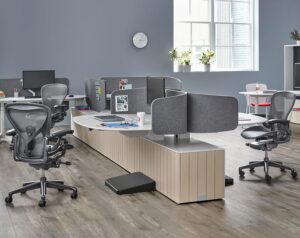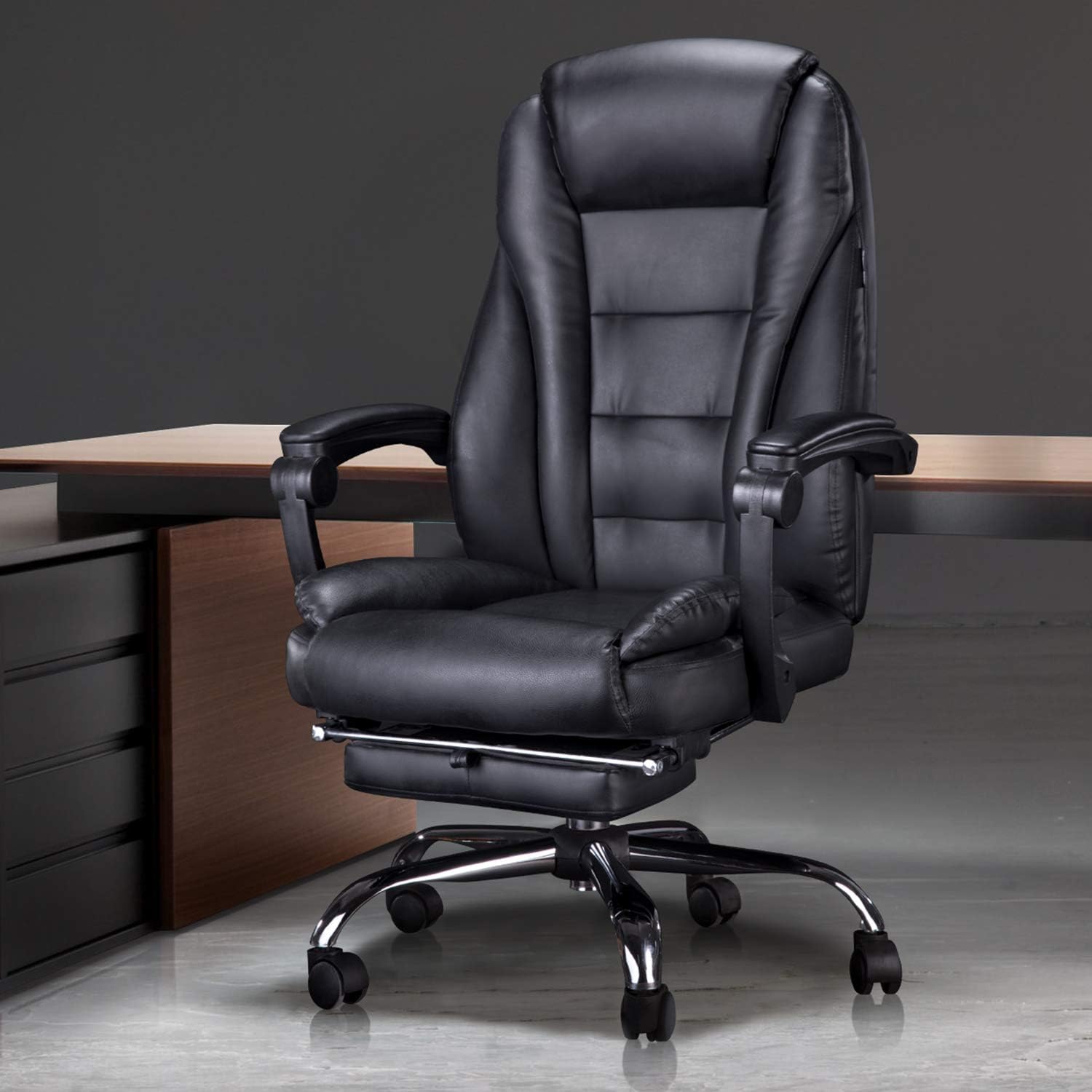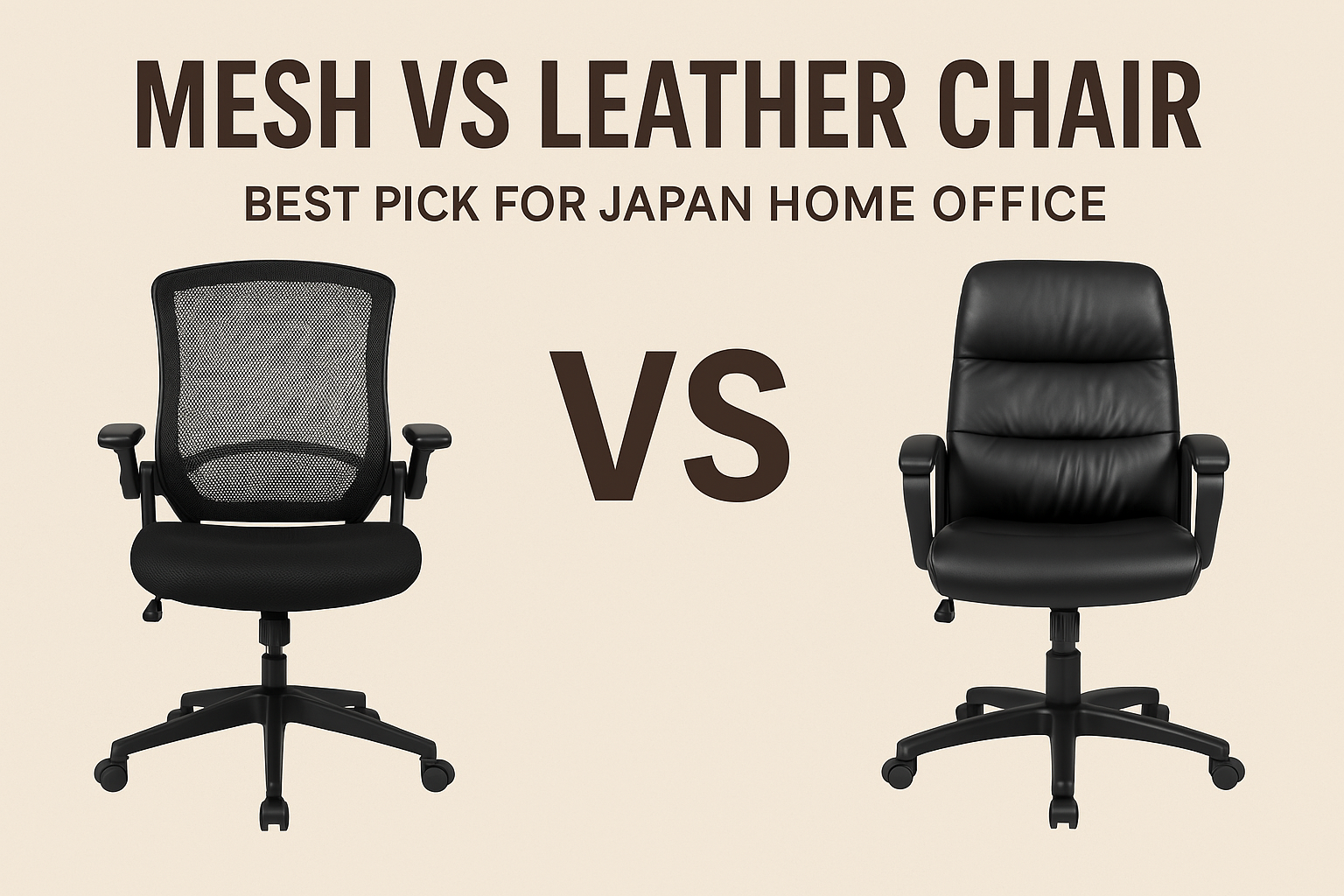Choosing the right chair can change how you work every day. If you’re working from home in Japan, your chair affects your focus, comfort, and even your health. Many people ask the same question: mesh chair vs leather—which one is better?
This guide compares both chair types from a practical, Japan-specific angle. Whether you’re battling humid summers, trying to stay productive in a small Tokyo apartment, or shopping for a budget-friendly setup online, this article is built for you.
- Why Chair Choice Matters
- Mesh Chairs: Pros and Cons
- Leather Chairs: Pros and Cons
- Feature Comparison Table
- Climate Tip: Japan’s Humidity Matters
- Real Use Case: Small Space Living
- Buying in Japan: Where to Find Good Deals
- Maintenance Tips for Japan-Based Users
- Sustainability Check
- Final Recommendation
- Next Steps
- Bottom Line
Why Chair Choice Matters
- You’ll spend over 1,800 hours per year sitting if you work from home full-time.
- Poor seating can lead to back pain, neck stiffness, and reduced productivity.
- A quality chair is not a luxury—it’s a necessity.
- The right chair can also influence your posture, mood, and even the quality of your sleep after work.
Many people in Japan work from home in small spaces, with limited airflow and long hours at the desk. Whether you’re in a Tokyo high-rise or a countryside apartment, making the right seating choice is essential.
Let’s break down the differences between mesh and leather chairs so you can decide what works best for your space, budget, and climate.
Mesh Chairs: Pros and Cons
What Is a Mesh Chair?
Mesh chairs are made with a breathable net-like fabric. The seat or back—or both—use mesh instead of solid cushioning. This flexible structure supports airflow and offers ergonomic benefits.
Pros
- Breathable: Great for Japan’s humid summers. Airflow keeps you cooler than leather.
- Lightweight: Easier to move around small spaces, especially useful in Japanese apartments.
- Flexible Back Support: Many mesh chairs contour to your spine and offer good ergonomic adjustments.
- Modern Look: Clean design fits minimalist or modern rooms.
- Affordable Options: Many choices under ¥20,000 on Amazon Japan.
- Easy to Clean: Dust and crumbs fall through or vacuum out easily.
- Supports Long Work Hours: Some models like the Herman Miller Aeron are specifically designed for 8+ hours of use.
Cons
- Less Cushioned: Some users find mesh seats less comfortable after long hours.
- Durability Varies: Lower-quality mesh can sag or tear over time.
- Less Formal: May not suit traditional or executive office aesthetics.
- Seat Pressure: Some users report that thin mesh seats create pressure on thighs after hours of sitting.
Best for:
- Freelancers or remote workers in hot climates.
- People with back pain needing flexible support.
- Those with modern or compact home setups.
- Workers who prefer firm support over soft padding.
Recommended Mesh Chairs (Amazon Japan)

Leather Chairs: Pros and Cons
What Is a Leather Chair?
Leather chairs use real or synthetic leather. They tend to look luxurious and have more padding. Some feature memory foam or layered cushioning for extra comfort.
Pros
- Padded Comfort: Soft cushioning makes them feel more premium.
- Professional Look: Perfect for video calls, meetings, or executive-style spaces.
- Durable: Genuine leather lasts years with proper care.
- Easy to Clean: Wipes clean—good for households with kids or pets.
- Classic Appeal: Suitable for both modern and traditional interiors.
- Warm Surface: Feels cozier during colder seasons, especially in northern Japan.
Cons
- Heat Retention: Uncomfortable during Japan’s summer unless you use air conditioning.
- Heavier: Harder to move, especially in small rooms.
- Higher Cost: Quality leather chairs often cost more than mesh options.
- Not as Breathable: Can feel sticky or sweaty after sitting for hours.
- Surface Wear: Faux leather may crack or peel over time if not maintained properly.
Best for:
- Cooler homes or well-air-conditioned spaces.
- People who prioritize style and comfort.
- Those who want a long-lasting, formal setup.
- Users who prefer soft seating with a plush feel.
Recommended Leather Chairs (Amazon Japan)

- Gtracing Gaming Office Chair Faux Leather
- Dowinx Ergonomic Leather Office Chair with Footrest
- Hbada Reclining Office Chair PU Leather
Feature Comparison Table
| Feature | Mesh Chair | Leather Chair |
|---|---|---|
| Comfort | Moderate to High (depends on padding) | High (soft cushioning) |
| Breathability | Excellent | Poor (especially in hot climates) |
| Ergonomics | Good (flexible, adjustable) | Moderate (some support) |
| Style | Modern, casual | Executive, formal |
| Durability | Varies by quality | High (genuine leather) |
| Weight | Lightweight | Heavy |
| Maintenance | Easy (wipe mesh, vacuum) | Easy (wipe, condition leather) |
| Price Range | ¥10,000–¥50,000 | ¥20,000–¥80,000+ |
| Heat Handling | Very good | Poor without AC |
Climate Tip: Japan’s Humidity Matters
Japan’s summer humidity can go over 80%. Mesh chairs help by allowing airflow and reducing sweat buildup. Leather chairs, unless you use AC often, can trap heat and feel sticky. This becomes especially uncomfortable when sitting for long periods without movement.
In places like Osaka, Tokyo, Fukuoka, and Nagoya—where summers are not only hot but also long—mesh chairs are often the smarter choice.
In Hokkaido or highland areas, leather may be fine year-round. Your home insulation and air conditioning habits also play a role.
Real Use Case: Small Space Living
In Japan, home offices are often part of the living room, kitchen area, or bedroom. Space-saving furniture is a priority. Mesh chairs:
- Save space due to slimmer frames.
- Are easy to slide under desks.
- Weigh less, so you can reposition them without hassle.
- Don’t dominate the room’s visual space.
Leather chairs:
- Often bulkier and heavier.
- May not fit well in tighter workspaces.
- Require more room due to their thick padding and wider base.
- Can double as lounge chairs if comfort is a priority.
If you’re sharing the home office with a partner or spouse, the mobility and compact design of mesh chairs might make co-working easier.
Buying in Japan: Where to Find Good Deals
You can buy both chair types on Amazon Japan, Rakuten, Nitori, and Yodobashi. Look for these features:
- Adjustable lumbar support
- Height adjustment
- Tilt/recline lock
- Weight capacity rating (over 100kg is better)
- Assembly instructions in English or Japanese
Don’t forget to check:
- Shipping fees (some sellers charge extra for large furniture)
- Return policies (especially if testing ergonomics at home)
- Customer reviews with photos (check comfort after months of use)
For budget-conscious buyers, start at the ¥10,000–¥20,000 range. Mesh chairs dominate this price bracket. Leather chairs in this range are usually faux leather and may lack adjustability.
For better ergonomics and long-term value, consider spending ¥30,000–¥60,000 for reliable performance and build quality.
Maintenance Tips for Japan-Based Users
Mesh Chair:
- Use a small vacuum weekly to remove dust.
- Avoid placing near windows to prevent sun damage.
- Tighten screws every few months.
- Avoid sharp objects like belt buckles that could tear the mesh.
Leather Chair:
- Wipe with a damp cloth weekly.
- Use a leather conditioner twice a year.
- Keep away from direct sunlight and heaters.
- Rotate use to avoid uneven wear if shared.
- Repair scratches early with leather repair kits available online.
Sustainability Check
Leather chairs, especially those made from animal leather, have a higher environmental impact. If eco-conscious choices matter to you, consider:
- PU leather (synthetic): Looks similar but more eco-friendly.
- Recycled mesh: Brands like Okamura and Itoki offer models made from recycled materials.
- Durability: A long-lasting chair is more sustainable than replacing a cheaper one every year.
- Packaging: Some brands now ship with reduced plastic or recyclable boxes.
Check our article on eco-friendly home office products in Japan for more tips.
Final Recommendation
Choose Mesh If:
- You live in a humid or hot climate.
- You want a light, breathable, and modern setup.
- Your home office is compact.
- Budget is under ¥30,000.
- You prioritize ergonomic features and airflow.
Choose Leather If:
- You work in a cold room or prefer warmth.
- You want a stylish, executive appearance.
- You sit for long hours and prefer plush cushioning.
- You can maintain the material regularly.
- You prefer chairs that also work as casual loungers.
Next Steps
- Want better posture? Read our guide on ergonomic tips for home offices in Japan.
- Need internet to match your chair comfort? Check out Japan internet remote work.
- Looking to upgrade your full setup? Visit our section on home office setups in Japan.
Bottom Line
The “mesh chair vs leather” decision depends on your climate, habits, and style. In Japan’s hot summers and small apartments, mesh usually wins on comfort and practicality. But if style, warmth, and softness matter more, leather could be worth it.
Your chair shapes your workday—so choose one that supports your health and matches your lifestyle. Consider the long-term use, your room size, and whether you prioritize cooling, support, or aesthetics. With the right chair, your home office becomes a place you look forward to sitting down in—every single day.


